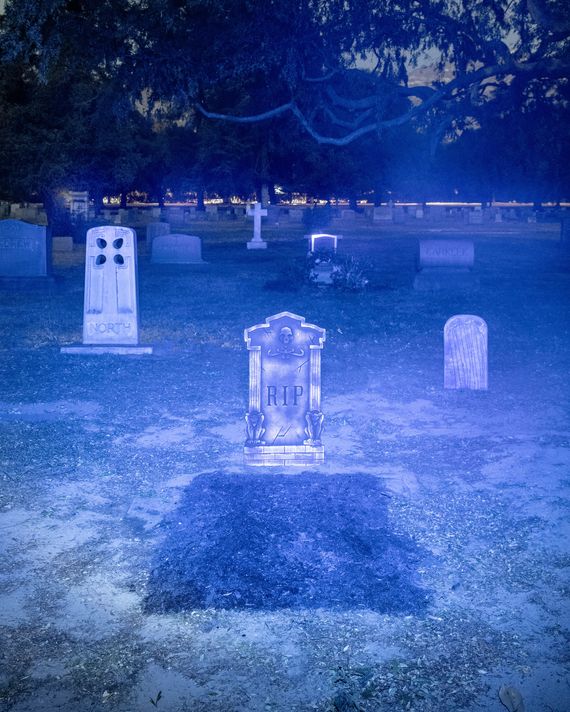
In the shadow of the San Gabriel Mountains just outside Pasadena, there’s a cemetery called Mountain View. It is not the showiest boneyard in greater Los Angeles. While Hollywood Forever and Forest Lawn are the famous final resting places of Walt Disney, Judy Garland, Clark Gable, and Dorothy Dandridge, hosting everything from movie screenings to haunted tours, Mountain View skews toward local Civil War ghosts and the ashes of original TV Superman George Reeves. Forest Lawn has Jean Harlow’s marble crypt; Hollywood Forever, the (perfect) statue of Johnny Ramone. Mountain View has a dutifully kept blog.
But that’s not all it has. Smack between two plots containing actual human remains is this Altadena cemetery’s most unusual secondary revenue stream: in the words of Mountain View’s office and operations manager, Luis Treto, “an empty grave we have that’s protected with steel so actors can get inside.”
A lot of cemeteries allow film shoots, but the Mountain View grave stands out. With a career spanning 30 years — her first onscreen credit was for a 1991 TV slasher movie called The Sitter — the Grave’s good looks and steel reinforcements have made her one of the most underrated character actors of our time. Deeply versatile, she has made her name in comedic roles. She’s the final resting place of George Costanza’s fiancée, poisoned by envelope glue, on Seinfeld. She’s where Richard Jenkins is buried in the pilot episode of Six Feet Under. She plays a pivotal role in I Think You Should Leave’s “Coffin Flop” sketch, when a corpse falls into her while Tim Robinson screams, “I don’t know what to tell you, bud, we’re just shooting funerals and showing the ones where the bodies fly out!” She has a star-making turn in Ozzy Osbourne’s music video for “Life Won’t Wait” and makes a cameo in a 2010 episode of CSI that Justin Bieber is in. In other words, she has been dug out and filled in countless times, the final resting place of hundreds of people who are completely made up.
One of the more beautiful and infuriating things about L.A. is that no one seems to realize when talking about an integral part of their business would create a sinkhole in the average person’s brain. I spent most of my life assuming that every burial scene was filmed on a studio lot that had existed since the silent era. But most productions opt for on-site realness, whether that means converting a local park or using the nearest cemetery willing to play ball with the location budget (see Buffy the Vampire Slayer’s upgrade from a parking-lot graveyard to a real one in Pico-Union). If you, like me, thought filming campy scenes in the middle of a field of corpses crossed an ethical line, well, I don’t know what we expected.
Mountain View Cemetery’s parlor features the same sterile smell and stiff furniture familiar to anyone who has ever lost someone they love, with pamphlets on how to talk to children about death and framed paintings of mourning flowers in vases. These offices are where Luis has worked since 2000 and where he’s the point of contact for as many as 50 film and TV shoots a year. He tells me Mountain View has angles that can look like almost anywhere. “There’s a corner area that I send a crew to if they need Florida,” he says, referring to a green, palm-tree-laden area in the back of the graveyard. There’s the spot near a crypt that’s popular for military- and police-funeral scenes, a palmless section that passes for the East Coast, and an area that, according to him, looks “like the 1960s.”
He seems surprised at my particular interest in the movie grave, as if it were no different from any other grave on the property. I ask him if he has any favorite productions that have filmed here in the past two decades. He sighs in a way I’m quickly learning is Classic Luis. “I mean, I don’t know. I don’t really watch too much,” he says.
I egg him on: “Coffin Flop”? Seinfeld? One of Luis’s co-workers, a 20-something named Nicole, perks up and turns to me.
“Are you serious?” she says. “Lady Gaga was here.”
Luis returns to his work as Nicole rattles off a list of Hollywood stars who have passed through Mountain View’s gates: the Lady Gaga shoot at the mausoleum for American Horror Story, an extended shoot for Perry Mason, a scene from Promising Young Woman that uses the offices we’re standing in. Nicole’s effusiveness gets the attention of another employee, an older man sitting behind a Dilbertian pile of office papers.
“Sean Penn!” he says over his desk. “And who’s that fella? The Rock!”
I leave the office pretending to remember the directions Luis gave me to the grave. It’s a fake grave, I thought. It can’t be that hard to find.
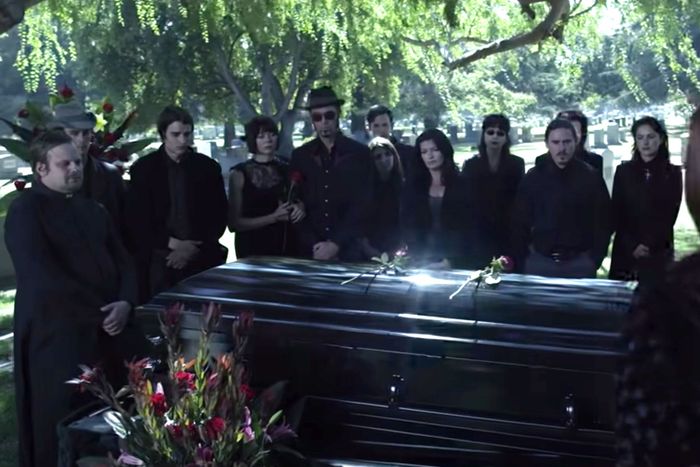
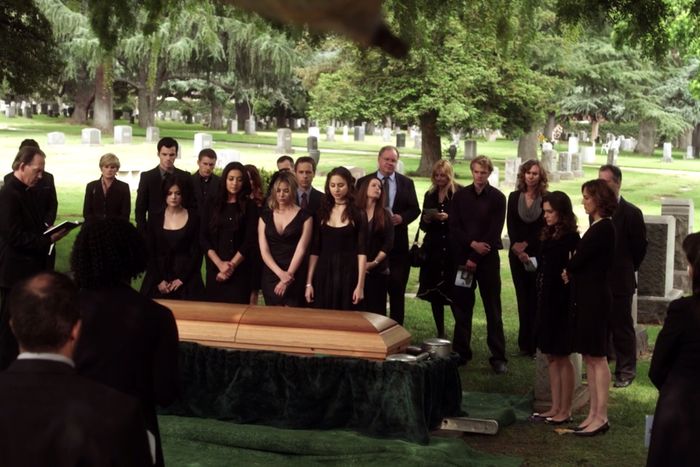
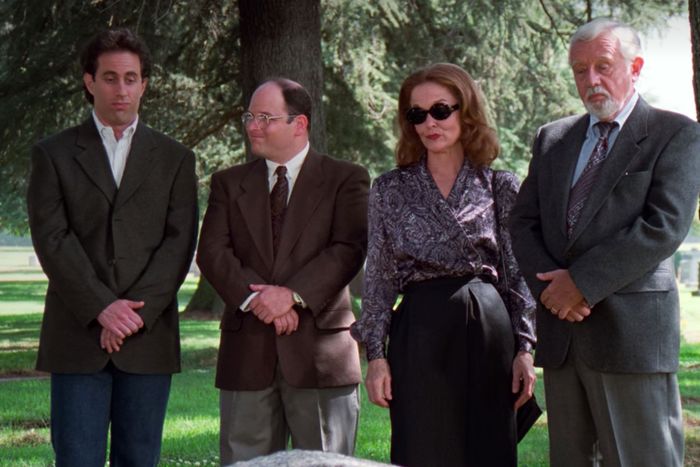
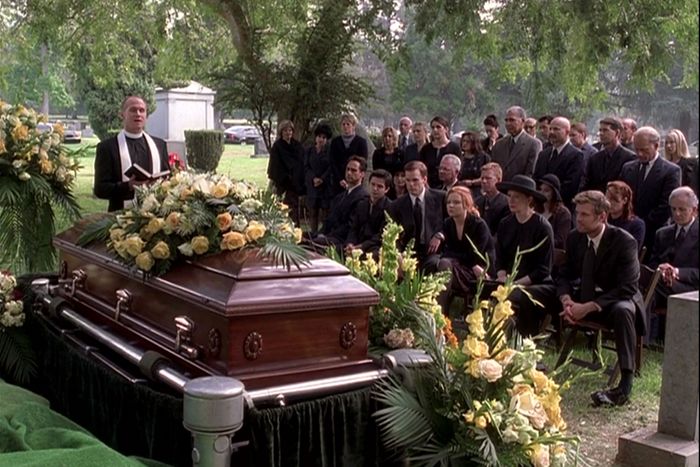
The role the grave performs time and again is rooted more in Hollywood convention than in the reality of American life. Fewer of us opt for burial than ever before; the cremation rate has steadily increased, to over 56 percent in 2020. Neither option is environmentally friendly, but cremation remains the more cost-effective choice. A reminder of this hovers over Mountain View as I wander the grounds in the form of a plume of black smoke.
The Grave exists outside all that, catering to the outsize demand to see death rituals onscreen. She can reveal a vulnerable side in a character we know: Steve Carell as Michael Scott in The Office, singing “American Pie” at the burial site of a catalogue model he fell in love with, or Lucy Liu as Joan Watson in Elementary, standing at her father’s grave while she tries to reconnect with a sibling. The Grave can develop a mystery, with the four sacred hotties from Pretty Little Liars inching closer to solving the fifth hottie’s murder while burying a red-herring suspect inside the Grave’s steel walls. She’s seen every trope: the sobbing, the dirt scattering, the upward-facing camera angle from the coffin’s perspective. She reflects the American way of death not as it exists but as we understand it to be when we throw on the Roku.
A full hour after leaving Mountain View’s office, I can’t find the plot. I’ve passed the area Luis rents for Florida swamp funerals, rolled my eyes walking by where fictional cops may be buried as if they were really doing something useful with their fictional lives, stumbled through rows that could almost pass for New England. What I haven’t found, no matter how many lefts my dumb ass takes, is the Grave. Just as I’m ready to give up, an unmarked white van pulls up beside me. It’s Luis.
“Did you find it?” he asks, looking encouraged that I’ve spent this much time on the premises.
“No,” I reply. He laughs and invites me into the van — the first recorded instance of someone getting into an unmarked white van hoping to meet a grave — and drives me to the site. It turns out that the Grave disappears into the role: I had walked past her twice.
She’s marked with only a little yellow spigot — this is a BYO-tombstone situation. Flanking the site are grave markers for people who have been dead nearly a hundred years, their headstones conveniently set into the ground. Luis gets out of the van and dusts off the plot to reveal a thick metal handle, the type found by a protagonist in the second act. He tugs on but doesn’t open it, explaining that productions renting the Grave can pry it open with special equipment, add some soil to the lining to make it look like an authentic hole, and put their own coffin and “dead” actor inside.
Mountain View’s location-shooting business is not mentioned on the cemetery’s website. According to both Luis and Sam Zuckerman, the co-producer who found the location for “Coffin Flop,” the Grave has no need for an agent; her reputation precedes her. I ask Luis if he has ever received a complaint from a mourner about filming near the Grave. He pauses. “I think our visitors find it interesting,” he says. “It brings life to the cemetery.”
Then he throws me a bone. “Wanna see a movie I liked?” he asks. He holds up his phone and shows me a scene from The Hangover Part III in which Alan (Zach Galifianakis) sings “Ave Maria” at the funeral of his father (Jeffrey Tambor). For all the movie’s faults, the Grave looks better than ever: She’s dressed in red-and-white flowers, a signature look, as Ed Helms and Bradley Cooper watch Galifianakis take a selfie with the coffin.
As we watch, a mourner sits in a lawn chair nearby, next to one of the real graves, listening to music on a boom box and drinking a can of soda. She waves hello. Luis is right: She doesn’t seem to have an issue with us tugging at a fake grave mere feet away. She’s spending time at a park where someone she loves is buried. Maybe the Grave is even one of the reasons she feels comfortable doing so. By the time I attended my first burial, I had already seen mourning playacted from the comfort of my parents’ living room over and over. All of the ideas I had about death outside my personal experiences with it were ones I had gotten from … well, movies. Many of them shot right where I was standing. The Grave remains criminally undercredited. But like any good character actor, you’ll never hear the Grave say a word about it.
"Hollywood" - Google News
October 28, 2021 at 07:00PM
https://ift.tt/3EsjuEX
A Date With the Grave - Vulture
"Hollywood" - Google News
https://ift.tt/38iWBEK
https://ift.tt/3fdiOHW
Bagikan Berita Ini
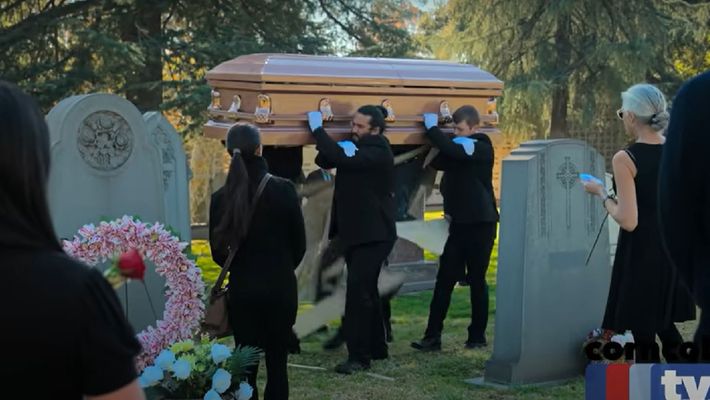














0 Response to "A Date With the Grave - Vulture"
Post a Comment